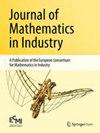Crack modeling via minimum-weight surfaces in 3d Voronoi diagrams
IF 1.7
Q3 MATHEMATICS, INTERDISCIPLINARY APPLICATIONS
引用次数: 1
Abstract
As the number one building material, concrete is of fundamental importance in civil engineering. Understanding its failure mechanisms is essential for designing sustainable buildings and infrastructure. Micro-computed tomography (μCT) is a well-established tool for virtually assessing crack initiation and propagation in concrete. The reconstructed 3d images can be examined via techniques from the fields of classical image processing and machine learning. Ground truths are a prerequisite for an objective evaluation of crack segmentation methods. Furthermore, they are necessary for training machine learning models. However, manual annotation of large 3d concrete images is not feasible. To tackle the problem of data scarcity, the image pairs of cracked concrete and corresponding ground truth can be synthesized. In this work we propose a novel approach to stochastically model crack structures via Voronoi diagrams. The method is based on minimum-weight surfaces, an extension of shortest paths to 3d. Within a dedicated image processing pipeline, the surfaces are then discretized and embedded into real μCT images of concrete. The method is flexible and fast, such that a variety of different crack structures can be generated in a short amount of time.在三维Voronoi图中通过最小重量曲面进行裂纹建模
混凝土作为第一建筑材料,在土木工程中起着至关重要的作用。了解其失效机制对于设计可持续建筑和基础设施至关重要。微计算机断层扫描(μCT)是一种成熟的虚拟评估混凝土裂缝萌生和扩展的工具。重建的三维图像可以通过经典图像处理和机器学习领域的技术进行检测。对裂缝分割方法进行客观评价的前提条件是真实的。此外,它们对于训练机器学习模型是必要的。然而,手工标注大型三维具体图像是不可行的。为了解决数据稀缺性问题,可以将混凝土裂缝图像对与相应的地面真值进行合成。在这项工作中,我们提出了一种通过Voronoi图随机模拟裂纹结构的新方法。该方法基于最小权曲面,将最短路径扩展到三维。在专用的图像处理管道中,将表面离散并嵌入到真实的混凝土μCT图像中。该方法灵活、快速,可在短时间内生成多种不同的裂纹结构。
本文章由计算机程序翻译,如有差异,请以英文原文为准。
求助全文
约1分钟内获得全文
求助全文
来源期刊

Journal of Mathematics in Industry
MATHEMATICS, INTERDISCIPLINARY APPLICATIONS-
CiteScore
5.00
自引率
0.00%
发文量
12
审稿时长
13 weeks
 求助内容:
求助内容: 应助结果提醒方式:
应助结果提醒方式:


